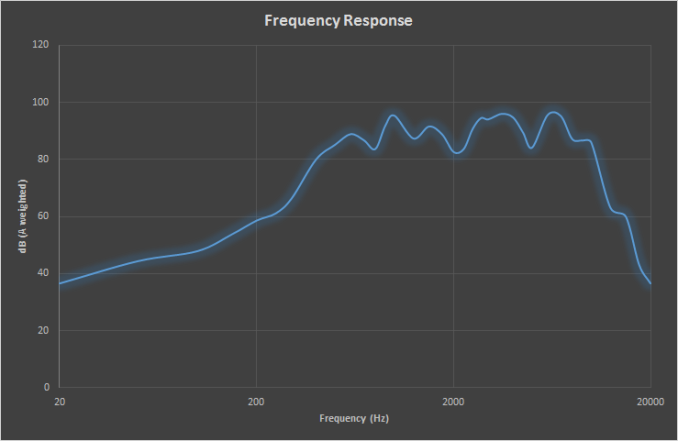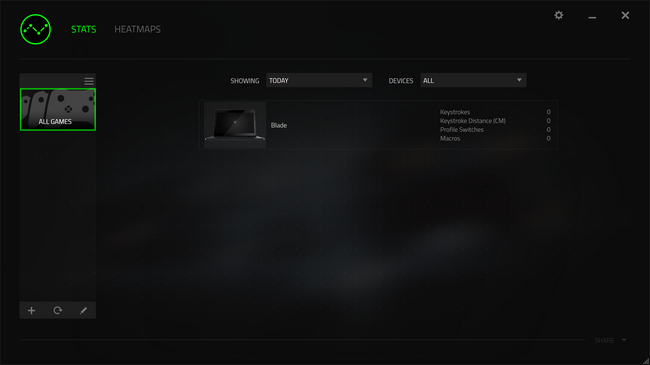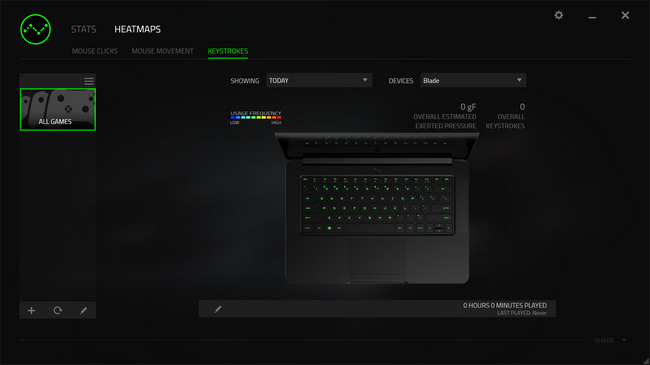The 2015 Razer Blade Review
by Brett Howse on February 11, 2015 2:00 PM EST- Posted in
- Laptops
- Razer
- Razer Blade
- Notebooks
- GTX970M
Speakers
The Razer has two front facing stereo speakers. With laptops this thin, there generally is not a lot of room for good sounding speakers, but I am ready to be surprised at any time. As for overall volume, the new Razer Blade comes in at 83 dBA. The 2014 Razer Blade did not impress me with its speaker quaility, which was disappointing due to not only the cost of the device, but the front facing speakers, which should have an advantage over any system which fires the speakers down, were very poor. With laptops getting as thin and small as they are now, forward facing speakers are less common, so I was looking for more on the 2014 model.
The frequency response for the 2015 Razer Blade is very much improved over the last model. The 2014 model had a very poor curve, and almost no sound at all under 200 Hz. As soon as the first frequency was tested it was obvious that some changes have been made to the speakers. I reached out to Razer, and asked them about the speakers. Although the actual speakers are the same, various subsystems have been changed. Some tuning has certainly been done to improve the overall sound quality, and it has made a big difference. When gaming, headphones will still be necessary to get rid of the fan noise, but for watching movies or listening to music, the speakers are much more usable now.
Software
The only software installed on the system, is Razer’s Synapse software. This in and of itself is worth mentioning due to the huge amount of extra software normally installed on new PCs. On a premium device such as this, it is nice to see that there are no bundled extras to increase Razer's margins. The Synapse software is their in-house software to control the Blade and other Razer peripherals. Razer Synapse has continued to evolve since we last took a look at it. We will not go over what has not changed, so if you want to check that out, it is detailed on our last review here. What is new is a new Stats option on the Synapse software. Opening this goes to some interesting software which lets you keep track of what you are doing while gaming.
Stats, once enabled, will keep track of total keystrokes, distance, profile switches, and macro use, to let you know just what it is you are doing in the heat of battle. And speaking of heat, moving over to the Heatmaps section displays some very cool graphics of where your mouse clicks occur on the screen, where you tend to move your mouse to, and what keys you use the most while gaming. Some of us are certainly not good enough gamers to gain any sort of insight with this data, but it is interesting to look at. For those that want the extra edge, it is a nice addition to the software.
This is what is new on the software, but no software is perfect, nor is any hardware. In future versions of the Synapse software, it would be nice to see some extra features that are missing from the Razer Blade.
First, and previously mentioned, is the lack of any sort of customization of the lighting scheme for the Razer Blade. The green is nice, but there are those of us who like to really make it our own. Alienware has done this for years, and Razer now has some nice looking RGB keyboards which offer some great customization and effects.
The other addition to the software is likely more functional. Fan control should be part of the Synapse software suite on laptops. As much as we like how silent the Razer Blade is doing light duty tasks, almost nothing is more annoying to some people than a fan that ramps up and down, rather than just stay constant. A nice addition would be multiple fan settings, which could be automatically enabled when the GPU kicks in. As we saw in the GPU load graph, there was no throttling at all on the GPU, but the temperature would go up and down like a saw blade. Give me an option to just leave the fans on maximum in that scenario.















116 Comments
View All Comments
peterfares - Thursday, February 12, 2015 - link
There are lots of issues with HDMI 1.4 and 2560x1440. Most don't seem to be able to do 2560x1440 at 60Hz.http://www.notebookcheck.net/2560x1440-or-2560x160...
Most of these tests were able to get 55Hz after setting a custom resolution. I tried once to get 2560x1440 60Hz out of a laptop with only HDMI and I couldn't do it whereas my laptops with DisplayPort I can just plug in and it works.
close - Thursday, February 12, 2015 - link
It doesn't mimic anything. It's just a good design. It's like saying that all cars mimic the Ford Model T or something. It is a shame indeed that it lack some connectivity but if they actually did study the market and most of their potential customers wanted this it sounds reasonable enough.Jaisah - Thursday, September 3, 2015 - link
The body is almost identical to the rMBP and even the inside (fan positioning, soldered ram and location, speaker position, battery position) looks very similar to the rMPB. Maybe they didn't copy the rMBP but they certainly used it for inspiration :PUplink10 - Wednesday, February 11, 2015 - link
Why do people buy laptops with pricey gimped i7 CPUs, which cost the same as ungimped CPUs. They should make laptop with i5 desktop CPU which is much cheaper but it is not gimped and has the same performance.dragonsqrrl - Wednesday, February 11, 2015 - link
... and a far higher TDP.Oh and the answer to your question: TDP (probably package size as well)
anactoraaron - Wednesday, February 11, 2015 - link
What? Did you just start reading AT? They analyzed this not too long ago. http://www.anandtech.com/show/7287/analyzing-the-p... The higher end quad w/ht i7 laptop chips hold their own against any desktop i5... and at a much lower tdp. I'm not sure how you define gimpedUplink10 - Wednesday, February 11, 2015 - link
They could have higher clocks but also a little higher TDP.DanNeely - Thursday, February 12, 2015 - link
Because at about the same TDP the mobile i7 is faster than the desktop i5. The 47W i7-4720m has a base of 2.6ghz and can turbo to 3.4-3.6. The 45W i5-4690T only has a base of 2.5GHz and tops out at 3.1-3.5 for turbo. The overall TDP between the two chips is closer because the desktop chipset is 4.1W vs 2.7 for the mobile one. To get faster than a baseline mobile i7 you need to go to the 65W S series i5s. Normal laptops don't do that because an extra 20W of TDP will give much better returns most of the time with a faster GPU. You'll occasionally see a desktop CPU it in an 18-19" luggable; but other than in form factor those machines don't really qualify as laptops because they're too big, too heavy, and have too little battery life even at idle to be usable away from a desk.And even at that, in turbo mode the top end end mobile 47W i7-4980HQ is faster than the 88w desktop i5.
Uplink10 - Thursday, February 12, 2015 - link
I thought you generally have laptop plugged in when playing games. And when you do not play games for few hours, you can use a CPU with little higher TDP.Brett Howse - Thursday, February 12, 2015 - link
It's not about battery life. You have to get the heat out. On a desktop PC, the headsink and fan combo is 3-4 times thicker than the entire laptop. Next, look at the cooling solution on a GTX 970 desktop part and then look at the laptop.